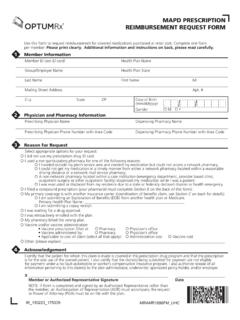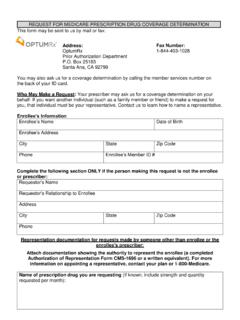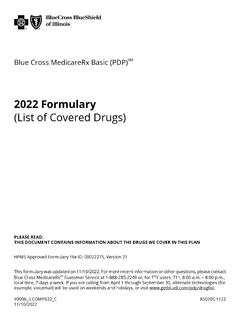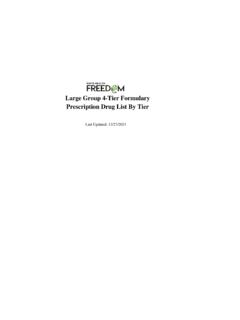Transcription of 2020 COMPLETE DRUG LIST (FORMULARY)
1 1. 2020. COMPLETE drug LIST. ( formulary ). Prescription drug list information AARP Medicare Advantage (HMO). AARP Medicare Advantage (HMO-POS). AARP Medicare Advantage Plan 1 (HMO). AARP Medicare Advantage Plan 2 (HMO). AARP Medicare Advantage Plan 3 (HMO). Important Notes: This document has information about the drugs covered by this plan. For more up-to-date information or if you have any questions, please call UnitedHealthcare Customer Service at: Toll-free 1-800-950-9355, TTY 711. 8 - 8 local time, 7 days a week formulary ID Number 00020047, Version 9. Y0066_190628_124536_C Last updated October 1, 2019. 2 11. TABLE OF CONTENTS. What is a drug list?..3. Note to existing 3. How do I use the drug list?..4. What are generic drugs?.. 4. What is a compounded drug ?..4. drug payment stage and drug 5. Getting Extra 5. Are there any rules or limits on my drug coverage?.. 6. What if my drug is not on this list?..8. How can I get an exception?..8. Can I get my drug while I wait for an exception?
2 9. Can the drug list change?.. 10. Drugs with dosages other than a 1-month covered drugs by name ( drug index).. 12. covered drugs by medical 29. covered drugs with a quantity limit (QL).. 108. Questions? If you have questions, we're here to help. Call UnitedHealthcare Customer Service at: Toll-free 1-800-950-9355, TTY 711. 8 - 8 local time, 7 days a week 2 3. What is a drug list? A drug list, or formulary , is a list of prescription drugs covered by your plan. Your plan and a team of health care providers work together in selecting drugs that are needed for well-rounded care and treatment. Your plan will generally cover the drugs listed in our drug list as long as: The drug is used for a medically accepted indication, The prescription is filled at a network pharmacy and Other plan rules are followed. For more information about your drug coverage, please review your Evidence of Coverage. Note to existing members: This COMPLETE list of prescription drugs covered by your plan is current as of October 1, 2019.
3 For an up-to-date list of covered drugs or if you have questions, please call UnitedHealthcare Customer Service. Our contact information is on the cover. This drug list has changed since last year. Please review this document to make sure your prescription drugs are still covered . In most cases, you must use network pharmacies to have your prescriptions covered by the plan. When this drug list refers to we, us, or our, it means UnitedHealthcare. When it refers to plan, our plan, or your plan, it means AARP Medicare Advantage Plans. 4 3. How do I use the drug list? There are 2 ways to find your prescription drugs in this drug list: 1. By name. Turn to section covered drugs by name ( drug index) on pages 12 28 to see the ..list of drug names in alphabetical order. Find the name of your drug . The page number where ..you can find the drug will be next to it. 2. By medical condition. Turn to section covered drugs by medical condition on pages ..29 107 to look for drugs based on your medical conditions.
4 For example, if you have a heart ..condition, you should look in the category Cardiovascular Agents. This is where you will find ..drugs that treat heart conditions. Can't find your drug ? Check the COMPLETE drug list by visiting our plan website at You can use online tools to look up your drugs. This information is updated on a regular basis. What are generic drugs? Generic drugs have the same active ingredients as brand name drugs. They usually cost less than brand name drugs and are approved by the Food and drug Administration (FDA). Our plan covers both brand name and generic drugs. Talk with your doctor to see if any of the brand name drugs you take have generic versions. Then review the drug list to make sure you are getting the drug you need for the least amount of money. The drug list shows brand name drugs in bold type (for example, Humalog) and generic drugs in plain type (for example, Simvastatin). What is a compounded drug ? A compounded drug is created by a pharmacist by combining or mixing ingredients to create a prescription medication customized to the needs of an individual patient.
5 Generally compounded drugs are non- formulary drugs (not covered ) by your plan. You may need to ask for and receive an approved coverage determination from us to have your compounded drug covered . Compounded drugs may be Part D eligible. For more information about compounded drugs, please review your Evidence of Coverage. 4 5. drug payment stage and drug tiers The amount you pay for a covered prescription drug will depend on: Your drug payment stage. Your plan has different stages of drug coverage. When you fill a prescription, the amount you pay depends on the coverage stage you're in. Your drug 's tier. Each covered drug is in 1 of 5 drug tiers. Each tier has a copay or coinsurance amount. The chart below shows the differences between the tiers. If you need help or have any questions about your drug costs, please review your Evidence of Coverage or call UnitedHealthcare Customer Service. Our contact information is on the cover. drug Tier Includes Tier 1: Lower-cost, commonly used generic drugs.
6 Preferred generic Tier 2: Many generic drugs. Generic Tier 3: Many common brand name drugs, called preferred Preferred brand brands and some higher-cost generic drugs. Tier 4: Non-preferred generic and non-preferred brand name Non-preferred drug drugs. Tier 5: Unique and/or very high-cost brand and generic drugs. Specialty tier Getting Extra Help If you qualify for Extra Help paying for your prescription drugs, your copays and coinsurance may be lower. Members who qualify for Extra Help will receive the Evidence of Coverage Rider for People Who Get Extra Help Paying for Prescription Drugs (LIS Rider). Please read it to learn about your costs. You can also call UnitedHealthcare Customer Service. Our contact information is on the cover..6 5 1. Are there any rules or limits on my drug coverage? Yes, some drugs may have coverage rules or have limits on the amount you can get. If your drug has any coverage rules or limits, there will be a code(s) in the Coverage Rules or Limits on use . column of the covered drugs by medical condition chart starting on page 29.
7 The codes and what they mean are shown below and on the next page. You can also get more information about the coverage rules and/or limits applied to specific covered drugs by visiting our website. We have posted online documents that explain our prior authorization and step therapy restrictions. If you would like a copy sent to you, please call UnitedHealthcare Customer Service. Our contact information is on the cover. Coverage Rules and Limits PA - Prior authorization The plan requires you or your doctor to get prior approval for certain drugs. This means the plan needs more information from your doctor to make sure the drug is being used correctly for a medical condition covered by Medicare. If you don't get approval, the plan may not cover the drug . QL - Quantity limits The plan will cover only a certain amount of this drug for 1 copay or over a certain number of days. These limits may be in place to ensure safe and effective use of the drug . If your doctor prescribes more than this amount or thinks the limit is not right for your situation, you or your doctor can ask the plan to cover the additional quantity.
8 ST - Step therapy There may be effective, lower-cost drugs that treat the same medical condition as this drug . You may be required to try 1 or more of these other drugs before the plan will cover your drug . If you have already tried other drugs or your doctor thinks they are not right for you, you or your doctor can ask the plan to cover this drug . 6 7. Other Special Coverage Rules B/D - Medicare Part B or Part D. Depending on how this drug is used, it may be covered by either Medicare Part B (doctor and outpatient health care) or Medicare Part D (prescription drugs). Your doctor may need to provide the plan with more information about how this drug will be used to make sure it's correctly covered by Medicare. LA - Limited access Drugs are considered limited access if the FDA says the drug can be given out only by certain facilities or doctors. These drugs may require extra handling, provider coordination or patient education that can't be done at a network pharmacy. MME - Morphine milligram equivalent Additional quantity limits may apply across all drugs in the opioid class used for the treatment of pain.
9 This additional limit is called a cumulative morphine milligram equivalent (MME), and is designed to monitor safe dosing levels of opioids for individuals who may be taking more than 1. opioid drug for pain management. If your doctor prescribes more than this amount or thinks the limit is not right for your situation, you or your doctor can ask the plan to cover the additional quantity. 7D - 7-Day limit An opioid drug used for the treatment of acute pain may be limited to a 7-day supply for members with no recent history of opioid use. This limit is intended to minimize long-term opioid use. For members who are new to the plan and have a recent history of using opioids, the limit may be overridden by having the pharmacy contact the plan. DL - Dispensing limit Dispensing limits apply to this drug . This drug is limited to a 1 month supply per prescription. For Track Refered Purpose You and your doctor may ask the plan for an exception to the coverage rules and/or limits for your drug . See section How can I get an exception?
10 " on page 8 or see your Evidence of Coverage to learn more. If you don't get approval from the plan before you fill a prescription for a drug with coverage rules or limits, you may have to pay the full cost of the drug . 8 7 Track What if my drug is not on this list? If your drug is not included in this drug list we may still cover it. Call UnitedHealthcare Customer Service to ask if it's covered . Our contact information, along with the date we last updated the drug list is on the cover. If you find out that your drug is not covered , you can do 1 of these things: 1. Ask UnitedHealthcare Customer Service for a list of similar drugs that are covered by the plan. When you get the list, show it to your doctor and ask him or her to prescribe a covered drug . 2. Ask the plan to make an exception and cover your drug . Review the next section for more exception information. How can I get an exception? Sometimes you may need to ask for drug coverage that's not normally provided by your plan. This is called asking for an exception.









